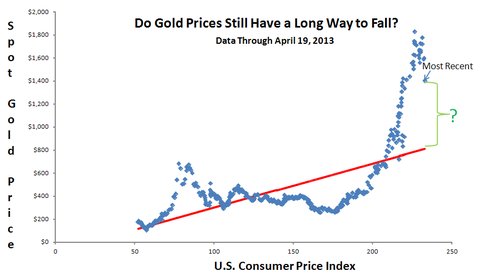A friend posed that question to me a few weeks ago, after watching gold’s wild ride over the last few years. The price of gold was less than $500 an ounce in 2005, but soared to more than $1,800 in 2011, before falling back to about $1,300 recently. He wasn’t sure what to make of it all.
My instinct was to say no. Like most economists I know, I am a pretty boring investor. I hold 60 percent stocks, 40 percent bonds, mostly in low-cost index funds. Whenever I see those TV commercials with some actor hawking gold coins, I roll my eyes. Hoarding gold seems akin to stocking up on canned beans and ammo as you wait for the apocalypse in your fallout shelter.
But I was also wary of imposing my gut instinct on my friend, who was looking for a more reasoned judgment. I knew that some investors saw gold as a key part of a portfolio. The author Harry Browne, the onetime Libertarian presidential candidate, recommended a permanent 25 percent allocation to gold. In 2012, the Federal Reserve reported that Richard Fisher, president of the Federal Reserve Bank of Dallas, had more than $1 million of gold in his personal portfolio.
So, before answering my friend’s question, I dived into the small academic literature on gold as a portfolio investment. Here is what I learned:
THERE ISN’T A LOT OF IT The World Gold Council estimates that all the gold ever mined amounts to 174,100 metric tons. If this supply were divided equally among the world’s population, it would work out to less than one ounce a person.
Warren E. Buffett has a good way to illustrate how little gold there is. He has calculated that if all the gold in the world were made into a cube, its edge would be only 69 feet long. So the cube would fit comfortably within a baseball infield.
Despite its small size, that cube would have substantial value. In a recent paper released by the National Bureau of Economic Research, Claude B. Erb and Campbell R. Harvey estimated that the value of gold makes up about 9 percent of the world’s market capitalization of stocks, bonds and gold. Much of the world’s gold, however, is out of the hands of private investors. About half of it is in the form of jewelry, and an additional 20 percent is held by central banks. This means that if you were to hold the available market portfolio, your asset allocation to gold would be about 2 percent.
ITS REAL RETURN IS SMALL Over the long run, gold’s price has outpaced overall prices as measured by the Consumer Price Index — but not by much. In another recent N.B.E.R. paper, the economists Robert J. Barro and Sanjay P. Misra reported that from 1836 to 2011, gold earned an average annual inflation-adjusted return of 1.1 percent. By contrast, they estimated long-term returns to be 1.0 percent for Treasury bills, 2.9 percent for long-term bonds and 7.4 percent for stocks.
Mr. Erb and Mr. Harvey presented a novel way of gauging gold’s return in the very long run: they compared what the Roman emperor Augustus paid his soldiers, measured in units of gold, to what we pay the military today.
They report remarkably little change over 2,000 years. The annual cost of one Roman legionary plus one Roman centurion was 40.9 ounces of gold. The annual cost of one United States Army private plus one Army captain has recently been 38.9 ounces of gold.
To be sure, military pay is a narrow measure, but this comparison offers some support for the view that, on average, gold should keep pace with wage inflation, which, thanks to productivity growth, runs slightly ahead of price inflation.
ITS PRICE IS HIGHLY VOLATILE Gold may offer an average return near that of Treasury bills, but its volatility is closer to that of the stock market.
That has been especially true since President Richard M. Nixon removed the last vestiges of the gold standard. Mr. Barro and Mr. Misra report that since 1975, the volatility of gold’s return, as measured by standard deviation, has been about 50 percent greater than the volatility of stocks.
Because gold is a small asset class with meager returns and high volatility, an investor may be tempted to avoid it altogether. But not so fast. One last fact may turn the tables.
IT MARCHES TO A DIFFERENT BEAT An important element of an investment portfolio is diversification, and here is where gold really shines — pun intended — because its price is largely uncorrelated with stocks and bonds. Despite gold’s volatility, adding a little to a standard portfolio can reduce its overall risk.
How far should an investor go? It’s hard to say, because optimal portfolios are so sensitive to expected returns on alternative assets, and expected returns are hard to measure precisely, even with a century or two of data. It is therefore not surprising that financial analysts reach widely varying conclusions.
•
In the end, I abandoned my initial aversion to holding gold. A small sliver, such as the 2 percent weight in the world market portfolio, now makes sense to me as part of a long-term investment strategy. And with several gold bullion exchange-traded funds now available, investing in gold is easy and can be done at low cost.
I will continue, however, to pass on the canned beans and ammo.

N. Gregory Mankiw is a professor of economics at Harvard.
Article source: http://www.nytimes.com/2013/07/28/business/budging-just-a-little-on-investing-in-gold.html?partner=rss&emc=rss

